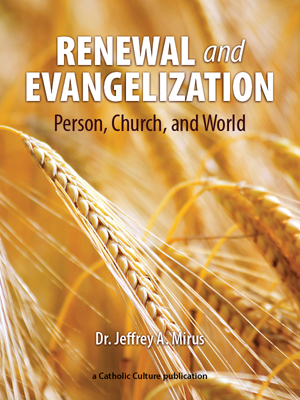The MOST Theological Collection: Catholic Apologetics Today: Answers to Modern Critics
"Chapter 9: Extra! Extra! Greek Doctor Writes Gospel!"
We are imagining how the Antioch Times-had there been such a publication-might have headlined it. It would have been true that Luke, a doctor from Antioch did write a Gospel. Yes, there are counter claims saying it was not Luke, and that Luke was not a doctor. We will take up those questions in the next chapter. However, for our purposes now, we need only know that he, and the other Synoptic writers, did intend to give us facts, plus interpretations. We now acknowledge that their intense concern for their own eternity would make them careful. We still have to ask to what extent they were in a position to get the facts. We will do that in the next chapter.
We want to stress, before beginning, that this chapter really is an "extra," and in a very real sense different from that of newspaper extras. It is "extra" in the sense that we do not need it at all. It is just a confirmation of what we saw in the last chapter. This chapter is not strictly conclusive, but it does give us impressive evidence, from entirely new research,37 that the author of Luke's Gospel was deeply concerned with accuracy.
Luke is the only Scriptural writer who was not a Semite. He was a Greek, an educated Greek, a doctor. For that reason, we need to recall Greek and Roman ideas on history writing.
We said previously that many Greeks and Romans held cyclic theories that contended that history is not going anywhere, that things just repeat themselves in cycles. That did not prevent them from writing up the history of certain stretches of those cycles as known to them. In Chapter 6 we saw some small part of the evidence that the Greek and Roman historians did intend to write facts plus interpretations, and that many of them did surprisingly well with their facts, though they lacked some of our techniques.
We should add that the ancient historians had another characteristic which we do not share. They would insert speeches in their histories at suitable points, e.g., the speech of Hannibal to his men before crossing the Alps. When it was obtainable, they would get at least the substance of what was said in these important speeches. Unfortunately, when the information was unavailable, they would make it up.
We should expect, then, that Luke, an educated Greek, would follow the Greek and Roman pattern of giving facts, carefully researched, plus interpretations. He is likely also to give speeches. In doing so, we should expect him to follow the Greek and Roman practice of trying to get at least the substance of the speeches. Could he do so? In the next chapter we will show that the answer is very definitely yes. But here we want to show that in doing his work, he used extraordinary, really meticulous care.
All scholars know and admit that the Greek of Luke's Gospel shows far more Semitisms than do the Gospels written by Semites. A Semitism consists in bringing some features of Semitic speech or structure into Greek, where it does not really belong. For example, in the parable of the wicked husbandmen, Mark's Gospel is content to merely say that after the first servant was mistreated, the master "sent another," and later again, "he sent another." But Luke 20:9-12 reads oddly, "And he added to send another servant"; and later, "he added to send a third." The language sounds stilted in English, and so did it in Greek. The reason is evident. Hebrew, in such a sentence, would use the root ysf; to add. So we can see Luke, who is not a Semite, is taking care to reproduce the precise structure of his source, a Hebrew source, although Mark, who was a Semite, did not do it. We notice in passing that many scholars think Luke copied much from Mark. This example proves he did not do it all the time, if ever.
But the most fascinating results come from studying what Luke does with a very odd Hebrew (not Aramaic38) construction called apodotic wau (which becomes apodotic kai in Greek, if used). Here is an example from Luke 5:1:39 "It happened, when the crowd pressed on Him to hear the word of God, AND He stood by the lake." We are struck by that odd and. It is surely out of place in English to use an and to connect the opening subordinate clause with the main clause. It is similarly out of place in Greek. It was not found in normal Aramaic either (except when they were tightly translating a Hebrew text, in the Targums40). But it is quite normal in Classical Hebrew.
Why did Luke insist on reproducing this bizarre Hebraism? The almost unanimous answer has been that he was deliberately imitating the Septuagint to give a Biblical flavor (the Septuagint is the old Greek translation of the Hebrew Old Testament). It is similar to injecting thee, thou, etc. etc. in English for the same purpose.
But we can prove statistically that Luke did not want to imitate the Septuagint.
First, we must check to find out if the Septuagint usually carried over into the Greek that Hebrew structure when it was found in the Old Testament. We are fortunate to have a very thorough study by M. Johannessohn on precisely this point.41 Johannessohn, by actual count, tells us the Septuagint for the most part does reproduce this Hebrew structure in Greek wherever it finds it.
So, if Luke really is imitating the Septuagint, we should expect him to use this structure most of the time too. If he does it only a small part of the time, it is as unlikely as if someone added thee, thou, etc., but did it only a small part of the time.
To reach some conclusion, I made two counts to see what Luke actually did. First, a count of how often Luke really does have the apodotic kai; second, a count of how many places he could have used it, were he really following the Septuagint practice of copying the Hebrew structure, but yet did not. The results of the two counts are surprising. Luke uses that Hebraism only one-fourth to one-fifth of the time!
Now imagine, again, someone injecting thee, thou, etc. to give a Biblical flavor in English, but doing it only one-fourth of the time. He would be inconsistent and odd. No intelligent person would do that-surely a doctor would not.
Still further, if we recall that sample passage of Luke 5:1 quoted earlier, we can notice there are three elements in the sentence: "1) And it happened; 2) when the crowd pressed on Him ... 3) AND He stood by the lake." Let us focus on the second item. It is an expression of time. Such time expressions commonly come ahead of this odd "and" structure in Hebrew. For the time expression, the Hebrew uses an odd bit of language-a preposition, "be," plus an infinitive-a construction which does not exist at all in English. But Greek did have a parallel structure, yet the Septuagint usually chose not to use that parallel Greek structure. Luke usually did choose to use it. So we see, again, Luke is not following the Septuagint, but is being tightly faithful to Hebrew structure.
What should we conclude? First, it is entirely obvious that the common view, that Luke used Semitisms to give a biblical flavor, like the Septuagint, is wrong. So then, what was his reason? Let's take seriously what Luke himself tells us in the opening lines of his Gospel. He says that he knows many have tried to compile a narrative of the things about Christ using eyewitnesses. He will write an orderly, careful account using such sources.
Now if Luke used sources, oral and written, he could easily have met sources in three languages-for there were three native languages for Jews in Palestine at that time, Aramaic, Hebrew and Greek.
Where he was using Greek sources, it would not, of course, affect his Greek. Greek on Greek does not show: Aramaic might show, but efforts of scholars to trace it have so far led to little general agreement.
But we have seen that in some places (20 to 25 percent of the time) he is following a Hebrew source. We would not expect him to use only Hebrew sources-he would be apt to use others, too. But the fact that he so carefully, even slavishly, imports strictly Hebrew (not Aramaic) structures into his Greek in this apodotic kai reveals his extreme care for accuracy. This slavish sort of Scriptural translation is known elsewhere, in some of the Old Latin translations, which bring Greek structures into Latin. We know too that the Latin translators did that out of extreme reverence for the sacred text, and extreme care to reproduce everything with utmost fidelity.
So then it is clear what Luke was doing. He did use sources, as he said; and he used them with such great care for fidelity that he even-not very suitably-brought Hebrew structures into Greek. We can conclude, therefore, that Luke must have taken meticulous care for accuracy.






